Curating 62 Years of Walnut Gulch Experimental Watershed Data: Improving the Quality of Long-Term Rainfall and Runoff Datasets
Abstract
:1. Introduction
2. Data Description and Quality Control Methodology
2.1. WGEW Data and Site Description
2.2. Past and Present QAQC Processes
2.3. Methods
- Visual inspection of spatial patterns of rainfall;
- Evaluation of the temporal relationships between rainfall and runoff events:
- Analysis of the relationship between the amount of rainfall and the amount of runoff.
- (1)
- Rainfall-runoff association method: A one-to-one association of rainfall and runoff events in which we evaluate the amount of rain observed within a given window of time for each runoff event. If there is no associated rainfall with the runoff event, it is flagged for further consideration.
- (2)
- Lag time method: There is certain amount of time that rainfall on a watershed takes to reach the outlet. Computing the value of the delay time between the runoff and the time of precipitation occurrence (lag time) allows us to evaluate if this time is physically realistic. The runoff leaving the outlet should not be too early (e.g., runoff before the rainfall starts) or too late (more than 2 h for medium sized watersheds in Walnut Gulch).
- (1)
- Runoff coefficient method: The runoff coefficient (depth of rainfall divided by the depth of runoff across the watershed) is the metric used in this test to identify runoff events that are physically unrealistic. Specifically, runoff events that are unrealistically large (ratio approaching a value of one (RC)) or associated with no rainfall (infinite value). Runoff coefficients approaching zero are not considered here due to measurement sensitivity/threshold issues at the low end.
- (2)
- Regression method: This test uses a rainfall-runoff regression model, fully outlined in Bitew et al., 2019 [54], to evaluate the temporal relationships between runoff and precipitation and incorporate watershed properties and antecedent conditions specific to the runoff event and watershed. This method flags suspicious events through comparison between predicted runoff, observed runoff, and the input precipitation.
2.3.1. Visual Inspection of Spatial Patterns of Rainfall
2.3.2. Rainfall-Runoff Association Method
2.3.3. Lag Time Method
2.3.4. Runoff Coefficient Method
2.3.5. Regression Method
2.4. Verification/Validation
2.5. Modeling of Ephemeral Systems
3. Results
3.1. Rainfall Observation Errors
3.2. Runoff Observation Errors
3.3. K2 Simulation Application
4. Discussion
5. Conclusions
Author Contributions
Funding
Institutional Review Board Statement
Informed Consent Statement
Data Availability Statement
Acknowledgments
Conflicts of Interest
References
- Tetzlaff, D.; Carey, S.K.; McNamara, J.P.; Laudon, H.; Soulsby, C. The essential value of long-term experimental data for hydrology and water management. Water Resour. Res. 2017, 53, 2598–2604. [Google Scholar] [CrossRef] [Green Version]
- Kleinman, P.J.A.; Spiegal, S.; Rigby, J.R.; Goslee, S.C.; Baker, J.M.; Bestelmeyer, B.T.; Duncan, E.W. Advancing the sustainability of US agriculture through long-term research. J. Environ. Qual. 2018, 47, 1412–1425. [Google Scholar] [CrossRef] [PubMed]
- Spiegal, S.; Bestelmeyer, B.T.; Archer, D.W.; Augustine, D.J.; Boughton, E.H.; Boughton, R.K.; Walthall, C.L. Evaluating strategies for sustainable intensification of US agriculture through the Long-Term Agroecosystem Research network. Environ. Res. Lett. 2018, 13, 034031. [Google Scholar] [CrossRef]
- Westerberg, I.; Walther, A.; Guerrero, J.L.; Coello, Z.; Halldin, S.; Xu, C.Y.; Lundin, L.C. Precipitation data in a mountainous catchment in Honduras: Quality assessment and spatiotemporal characteristics. Appl. Clim. 2010, 101, 381–396. [Google Scholar] [CrossRef]
- Brantley, S.L.; McDowell, W.H.; Dietrich, W.E.; White, T.S.; Kumar, P.; Anderson, S.P.; Gaillardet, J. Designing a network of critical zone observatories to explore the living skin of the terrestrial Earth. Earth Surf. Dyn. 2017, 5, 841–860. [Google Scholar] [CrossRef] [Green Version]
- Knapp, A.K.; Smith, M.D.; Hobbie, S.E.; Collins, S.L.; Fahey, T.J.; Hansen, G.J.; Webster, J.R. Past, Present, and Future Roles of Long-Term Experiments in the LTER Network. Bioscience 2012, 62, 377–389. [Google Scholar] [CrossRef] [Green Version]
- Collinge, S.K. NEON is your observatory. Front. Ecol. Environ. 2018, 16, 371. [Google Scholar] [CrossRef] [Green Version]
- Kauffeldt, A.; Halldin, S.; Rodhe, A.; Xu, C.-Y.; Westerberg, I.K. Disinformative data in large-scale hydrological modelling. Hydrol. Earth Syst. Sci. 2013, 17, 2845–2857. [Google Scholar] [CrossRef] [Green Version]
- Lundquist, J.D.; Wayand, N.E.; Massmann, A.; Clark, M.P.; Lott, F.; Cristea, N.C. Diagnosis ofinsidious data disasters. Water Resour. Res. 2015, 51, 3815–3827. [Google Scholar] [CrossRef]
- Kautz, M.A.; Holifield Collins, C.D.; Guertin, D.P.; Goodrich, D.C.; van Leeuwen, W.J.; Williams, C.J. Hydrologic model parameterization using dynamic Landsat-based vegetative estimates within a semiarid grassland. J. Hydrol. 2019, 575, 1073–1086. [Google Scholar] [CrossRef]
- Korgaonkar, Y.; Guertin, D.P.; Goodrich, D.C.; Unkrich, C.; Kepner, W.G.; Burns, I.S. Modeling urban hydrology and green infrastructure using the AGWA urban tool and the KINEROS2 model. Front. Built Environ. 2018, 4, 1–15. [Google Scholar] [CrossRef] [Green Version]
- Goodrich, D.C.; Burns, I.S.; Unkrich, C.L.; Semmens, D.; Guertin, D.P.; Hernandez, M.; Yatheendradas, S.; Kennedy, J.R.; Levick, L. KINEROS2/AGWA: Model Use, Calibration, and Validation. Trans. ASABE 2012, 55, 1561–1574. [Google Scholar] [CrossRef]
- Houser, P.R.; Shuttleworth, W.J.; Famiglietti, J.S.; Gupta, H.V.; Syed, K.H.; Goodrich, D.C. Integration of soil moisture remote sensing and hydrologicmodeling using data assimilation. Water Resour. Res. 1998, 34, 3405–3420. [Google Scholar] [CrossRef] [Green Version]
- Doll, P.; Siebert, S. Global Modeling of Irrigation Water Requirements. Water Resour. Res. 2002, 38, 8-1–8-10. [Google Scholar] [CrossRef]
- Fekete, B.M.; Vörösmarty, C.J.; Roads, J.O.; Willmott, C.J. Uncertainties in precipitation and their impacts on runoff estimates. J. Clim. 2004, 17, 294–304. [Google Scholar] [CrossRef]
- Güntner, A. Improvement of Global Hydrological Models Using GRACE Data. Surv. Geophys. 2008, 29, 375–397. [Google Scholar] [CrossRef] [Green Version]
- Beven, K.; Westerberg, I. On red herrings and real herrings: Disinformation and information in hydrological inference. Hydrol. Processes 2011, 25, 1676–1680. [Google Scholar] [CrossRef]
- Beven, K.J.; Smith, P.J.; Wood, A. On the colour and spin of epistemic error, and what we might do about it. Hydrol. Earth Syst. Sci. 2011, 15, 3123–3133. [Google Scholar] [CrossRef] [Green Version]
- Sapač, K.; Rusjan, S.; Šraj, M. Assessment of consistency of low-flow indices of a hydrogeologically non-homogeneous catchment: A case study of the Ljubljanica river catchment, Slovenia. J. Hydrol. 2020, 583, 124621. [Google Scholar] [CrossRef]
- Yilmaz, K.K.; Gupta, H.V.; Wagener, T. A process-based diagnostic approach to model evaluation: Application to the NWS distributed hydrologic model. Water Resour. Res. 2008, 44, W09417. [Google Scholar] [CrossRef] [Green Version]
- de Vos, L.W.; Leijnse, H.; Overeem, A.; Uijlenhoet, R. Quality control for crowdsourced personal weather stations to enable operational rainfall monitoring. Geophys. Res. Lett. 2019, 46, 8820–8829. [Google Scholar] [CrossRef] [Green Version]
- Aguilar, E.; Peterson, T.C.; Obando, P.R.; Frutos, R.; Retana, J.A.; Solera, M.; Mayorga, R. Changes in precipitation and temperature extremes in Central America and northern South America, 1961–2003. J. Geophys. Res. 2005, 110, D23107. [Google Scholar] [CrossRef]
- Evett, S.R.; Marek, G.W.; Copeland, K.S.; Colaizzi, P.D. Quality Management for Research Weather Data: USDA-ARS, Bushland, TX. Agrosystems Geosci. Environ. 2018, 1, 1–18. [Google Scholar] [CrossRef] [Green Version]
- Kunkel, K.E.; Easterling, D.R.; Hubbard, K.; Redmond, K.; Andsager, K.; Kruk, M.C.; Spinar, M.L. Quality control of pre-1948 cooperative observer network data. J. Atmos. Ocean. Technol. 2005, 22, 1691–1705. [Google Scholar] [CrossRef] [Green Version]
- You, J.; Hubbard, K.G.; Nadarajah, S.; Kunkel, K.E. Performance of quality assurance procedures on daily precipitation. J. Atmos. Ocean. Technol. 2007, 24, 821–834. [Google Scholar] [CrossRef]
- Eischeid, J.K.; Baker, C.B.; Karl, T.R.; Diaz, H.F. The quality control of long-term climatological data using objetive data analysis. J. Appl. Meteor. 1995, 34, 2787–2795. [Google Scholar] [CrossRef] [Green Version]
- Renard, K.G.; Nichols, M.H.; Woolhiser, D.A.; Osborn, H.B. A brief background on the U.S. Department of Agricul-ture Agricultural Research Service Walnut Gulch Experimental Watershed. Water Resour. Res. 2008, 44, W05S02. [Google Scholar] [CrossRef] [Green Version]
- Goodrich, D.C.; Heilman, P.; Nearing, M.; Nichols, M.; Scott, R.; Williams, J.; Biederman, J. The USDA-Agricultural Research Service’s Long Term Agroecosystems Walnut Gulch Experimental Watershed. Hydro. Proces. 2021, 35, e14349. [Google Scholar] [CrossRef]
- Goodrich, D.C.; Heilman, P.; Anderson, M.; Baffaut, C.; Bonta, J.; Bosch, D.; Bryant, R.; Cosh, M.; Endale, D.; Veith, T.L.; et al. The USDA-ARS Experimental Watershed Network-Evolution, Lessons Learned, Societal Benefits, and Moving Forward. Water Resour. Res. 2021, 57, e2019WR026473. [Google Scholar] [CrossRef]
- Baffaut, C.; Baker, J.M.; Biederman, J.A.; Bosch, D.D.; Brooks, E.S.; Buda, A.R.; Demaria, E.M.; Yasarer, L.M. Comparative Analysis of Water Budgets across the U.S. Long-Term Agroecosystem Research Network. J. Hydrol. 2020, 588, 125021. [Google Scholar] [CrossRef]
- Fiebrich, C.A.; Crawford, K.C. The impact of unique meteorological phenomena detected by the Oklahoma Mesonet and ARS Micronet on automated quality control. Bull. Am. Meteorol. Soc. 2001, 82, 2173–2187. [Google Scholar] [CrossRef] [Green Version]
- Brakensiek, D.L.; Osborn, H.B.; Rawls, W.J. Field Manual for Research in Agricultural Hydrology. U. S.; Department of Agriculture, Agriculture Handbook No. 224; Department of Agriculture, Science and Education Administration: Washington, DC, USA, 1979; 550p. [Google Scholar]
- Moran, M.S.; Emmerich, W.E.; Goodrich, D.C.; Heilman, P.; Holifield Collins, C.; Keefer, T.O.; Nearing, M.A.; Nichols, M.H.; Renard, K.G.; Scott, R.L.; et al. Preface to special section on Fifty Years of Research and Data Collection: U.S. Department of Agriculture Walnut Gulch Experimental Watershed. Water Resour. Res. 2008, 44, W05S01. [Google Scholar] [CrossRef] [Green Version]
- Nichols, M.H.; Anson, E. Southwest watershed research center data access project. Water Resour. Res. 2008, 44, W05S03. [Google Scholar] [CrossRef] [Green Version]
- Renard, K.G.; Lane, L.J.; Simanton, J.R.; Emmerich, W.E.; Stone, J.J.; Weltz, M.A.; Goodrich, D.C.; Yakowitz, D.S. Agricultural impacts in an arid environment: Walnut Gulch studies. Hydrol. Sci. Technol. 1993, 9, 149–159. [Google Scholar]
- Demaria, E.M.C.; Goodrich, D.C.; Kunkel, K.E. Evaluating the reliability of the U.S. Cooperative Observer Program precipitation observations for extreme events analysis using the LTAR network. J. Atmos. Ocean Technol. 2019, 36, 317–332. [Google Scholar] [CrossRef] [Green Version]
- Roeske, R.H.; Garrett, J.M.; Eychaner, J.H. Floods of October 1983 in southeastern Arizona, U.S. Geol. Surv. Water Resour. Investig. Rep. 1989, 98-4225-c. [Google Scholar]
- Keefer, T.O.; Renard, K.G.; Goodrich, D.C.; Heilman, P.; Unkrich, C.L. Quantifying Extreme Precipitation Events and their Hydrologic Response in Southeastern Arizona. J. Hydrol. Eng. 2015, 21, 1–10. [Google Scholar] [CrossRef] [Green Version]
- Goodrich, D.C.; Lane, L.J.; Shillito, R.M.; Miller, S.N.; Syed, K.H.; Woolhiser, D.A. Linearity of basin response as a function of scale in a semiarid watershed. Water Resour. Res. 1997, 33, 2951–2965. [Google Scholar] [CrossRef]
- Keefer, T.O.; Moran, M.S.; Paige, G.B. Long-term precipitation database, Walnut Gulch Experimental Watershed, Arizona, United States. Water Resour. Res. 2008, 44, W05S07. [Google Scholar] [CrossRef] [Green Version]
- Garcia, M.; Peters-Lidard, C.D.; Goodrich, D.C. Spatial interpolation of precipitation in a dense gauge network for monsoon storm events in the southwestern United States. Water Resour. Res. 2008, 44, W05S13. [Google Scholar] [CrossRef] [Green Version]
- Smith, R.E.; Chery, D.L.; Renard, K.G.; Gwinn, W.R. Supercritical Flow Flumes for Measuring Sediment-Laden Flow; USDA ARS Technical Bulletins 1655; US Department of Agriculture, Agricultural Research Service: Washington, DC, USA, 1982.
- Stone, J.J.; Nichols, M.H.; Goodrich, D.C.; Buono, J. Longterm runoff database, Walnut Gulch Experimental Watershed, Arizona, United States. Water Resour. Res. 2008, 44, W05S05. [Google Scholar] [CrossRef] [Green Version]
- Nichols, M.H.; Stone, J.J.; Nearing, M.A. Sediment database, Walnut Gulch Experimental Watershed, Arizona, United States. Water Resour. Res. 2008, 44, W05S06. [Google Scholar] [CrossRef] [Green Version]
- Keefer, T.O.; Unkrich, C.L.; Smith, J.R.; Goodrich, D.C.; Moran, M.S.; Simanton, J.R. An event-based comparison of two types of automated-recording, weighing bucket rain gauges. Water Resour. Res. 2008, 44, W05S12. [Google Scholar] [CrossRef] [Green Version]
- Osborn, H.B.; Lane, L.J.; Myers, V.A. Rainfall/watershed relationships for southwestern thunderstorms. Trans. ASAE 1980, 23, 82–87. [Google Scholar] [CrossRef]
- Reich, B.M.; Osborn, H.B. Improving Point Rainfall Prediction with Experimental Data? Mississippi State University: Starkville, MS, USA, 1982; pp. 41–54. [Google Scholar]
- Osborn, H.B.; Lane, L. Precipitation-runoff relations for very small semiarid rangeland watersheds. Water Resour. Res. 1969, 5, 419–425. [Google Scholar] [CrossRef]
- Simanton, J.R.; Osborn, H.B. Runoff estimates for thunderstorm rainfall on small rangeland watersheds. In Hydrology and Water Resources in Arizona and the Southwest; Arizona-Nevada Academy of Science: Flagstaff, AZ, USA, 1983; Volume 13, pp. 9–15. [Google Scholar]
- Kampf, S.K.; Faulconer, J.; Shaw, J.R.; Lefsky, M.; Wagenbrenner, J.W.; Cooper, D.J. Rainfall thresholds for flow generation in desert ephemeral streams. Water Resour. Res. 2018, 54, 9935–9950. [Google Scholar] [CrossRef]
- Syed, K.H.; Goodrich, D.C.; Myers, D.E.; Sorooshian, S. Spatial characteristics of thunderstorm rainfall fields and their relation to runoff. J. Hydrol. 2003, 271, 1–21. [Google Scholar] [CrossRef] [Green Version]
- Goodrich, D.C.; Chehbouni, A.; Goff, B.; MacNish, B.; Maddock, T.; Moran, S.U.S.A.N.; Yucel, I. Preface paper to the Semi-Arid LandSurface-Atmosphere (SALSA) program special issue. Agric. For. Meteorol. 2000, 105, 3–20. [Google Scholar] [CrossRef]
- Yatheendradas, S.; Wagener, T.; Gupta, H.; Unkrich, C.; Goodrich, D.; Schaffner, M.; Stewart, A. Understanding uncertainty in distributed flash flood forecasting for semiarid regions. Water Resour. Res. 2008, 44, W05S19. [Google Scholar] [CrossRef]
- Bitew, M.M.; Goodrich, D.C.; Demaria, E.; Heilman, P.; Nichols, M.; Levick, L.; Unkrich, C.L.; Kautz, M. Multi-parameter regression modeling for improving the quality of measured rainfall and runoff data in densely instrumented watersheds. J. Hydrol. Eng. 2019, 24, 04019036. [Google Scholar] [CrossRef] [Green Version]
- Houser, P.; Goodrich, D.; Syed, K. Runoff, precipitation, and soil moisture at Walnut Gulch. In Spatial Patterns in Catchment Hydrology: Observations and Modelling; Grayson, R., Blöschl, G., Eds.; Cambridge University Press: Cambridge, UK, 2000; pp. 125–157. [Google Scholar]
- Akaike, H. Information Theory and An Extension of the Maximum Likelihood Principle. In International Syrup on Information Theory, 2nd ed.; Petrov, B.N., Csaki, F., Eds.; Akademia Kiado: Budapest, Hungary, 1973; pp. 267–281. [Google Scholar]
- SCS (Soil Conservation Service). Hydrology National Engineering Handbook; SCS: Washington, DC, USA, 1972. [Google Scholar]
- Semmens, D.; Goodrich, D.C.; Unkrich, C.L.; Smith, R.E.; Woolhiser, D.A.; Miller, S.N. Hydrological Modelling in Arid and Semi-arid Areas; KINEROS2 and the AGWA Modeling Framework; Cambridge University Press: Cambridge, UK, 2005; pp. 49–68. [Google Scholar]
- Smith, R.E.; Goodrich, D.C.; Woolhiser, D.A.; Unkrich, C.L. KINEROS2—A KINematic Runoff and EROSion Model. In Computer Models of Watershed Hydrology; Singh, V.P., Ed.; Water Resources Publication: Highlands Ranch, CO, USA, 1995; pp. 697–732. [Google Scholar]
- Gupta, H.V.; Wagener, T.; Liu, Y. Reconciling theory with observations: Elements of a diagnostic approach to model evaluation. Hydrol. Processes 2008, 22, 3802–3813. [Google Scholar] [CrossRef]
- McMillan, H.; Krueger, T.; Freer, J. Benchmarking observational uncertainties for hydrology: Rainfall, river discharge and water quality. Hydrol. Processes 2012, 26, 4078–4111. [Google Scholar] [CrossRef]
- McCord, S.E.; Webb, N.P.; Van Zee, J.W.; Burnett, S.H.; Christensen, E.M.; Ericha, C.M.; Laney, C.M.; Lunch, C.; Maxwell, C.; Karl, J.W.; et al. Provoking a cultural shift in data quality. Front. Ecol. Environ. 2021, 71, 647–657. [Google Scholar] [CrossRef]
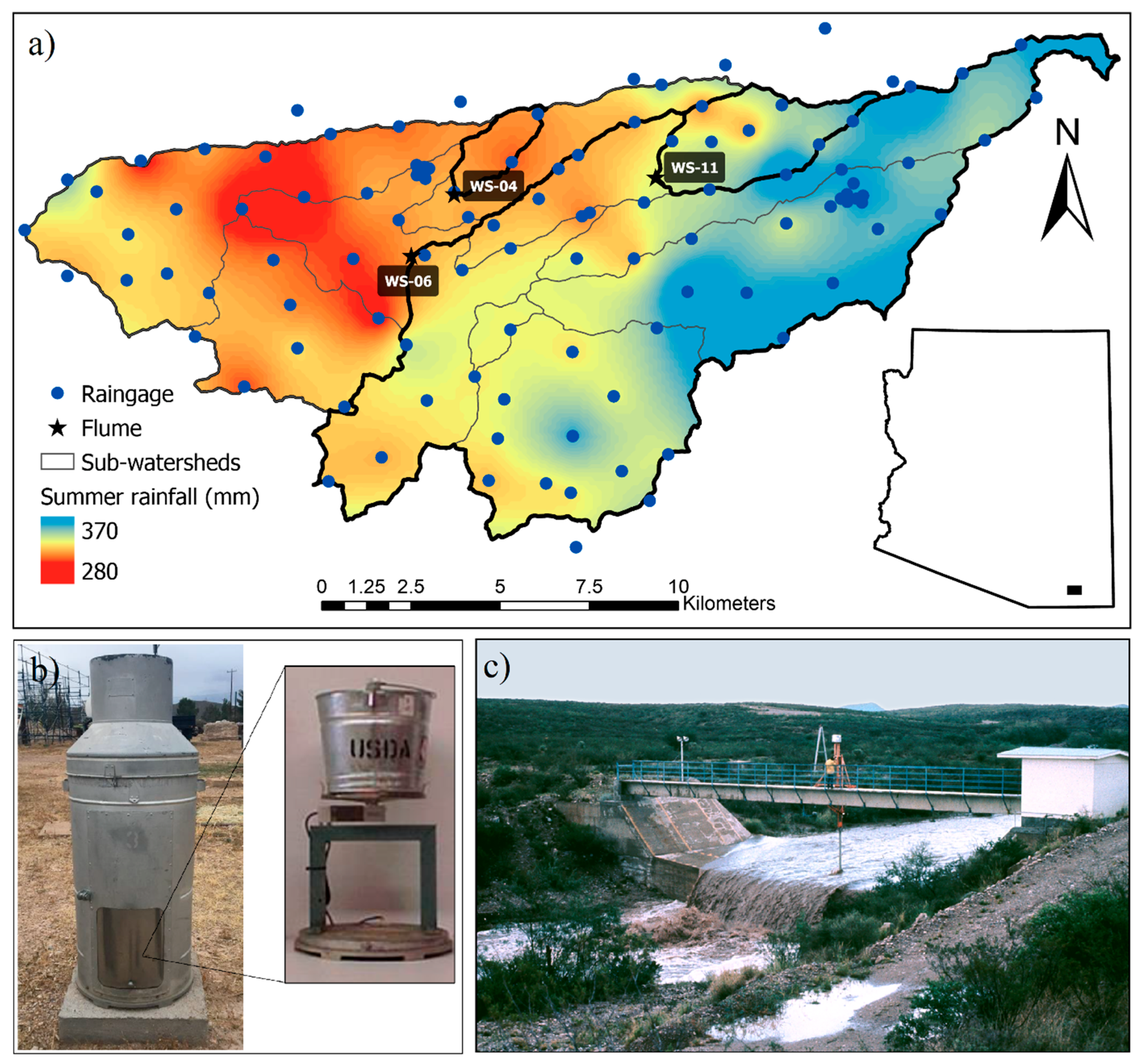

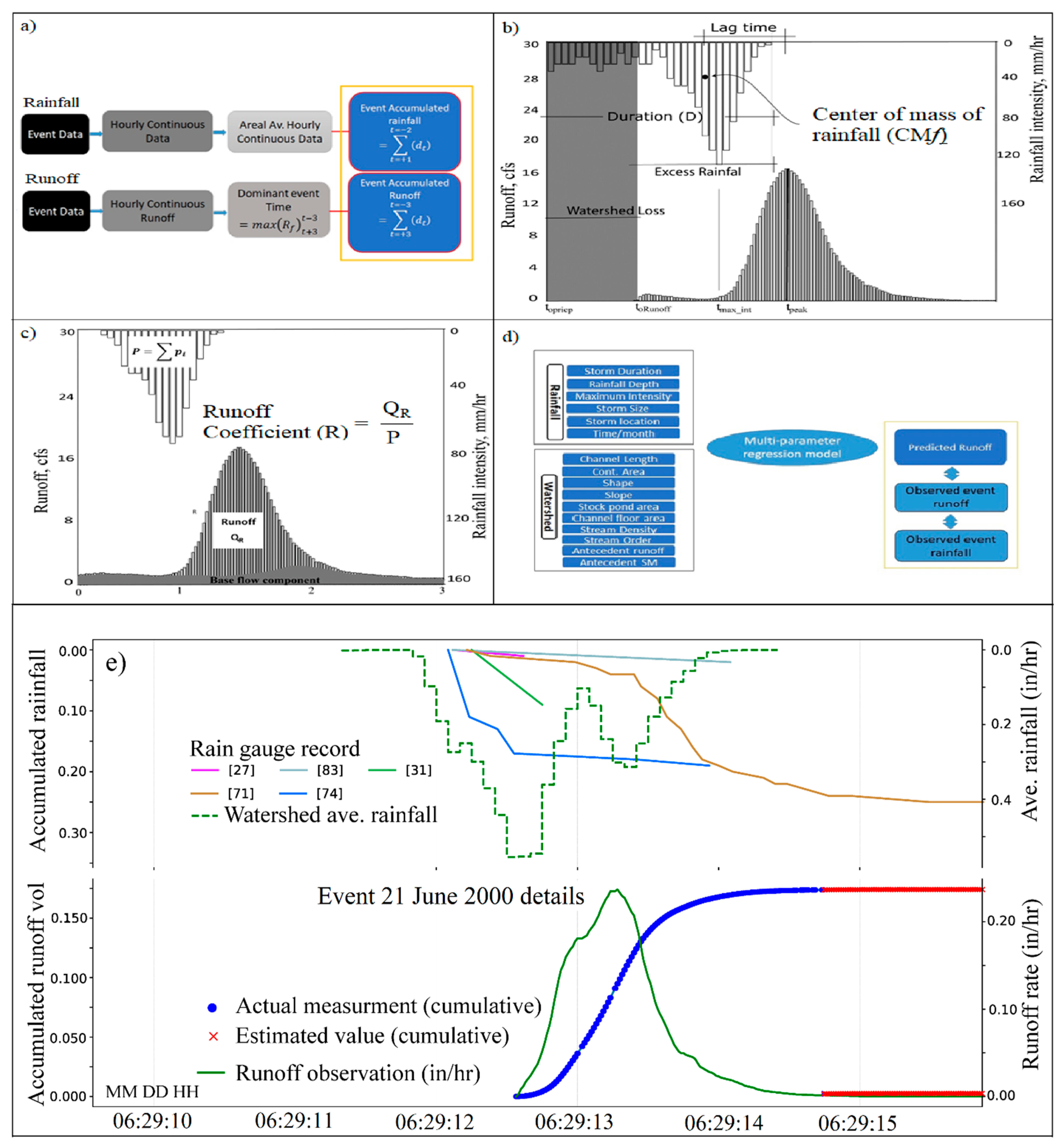
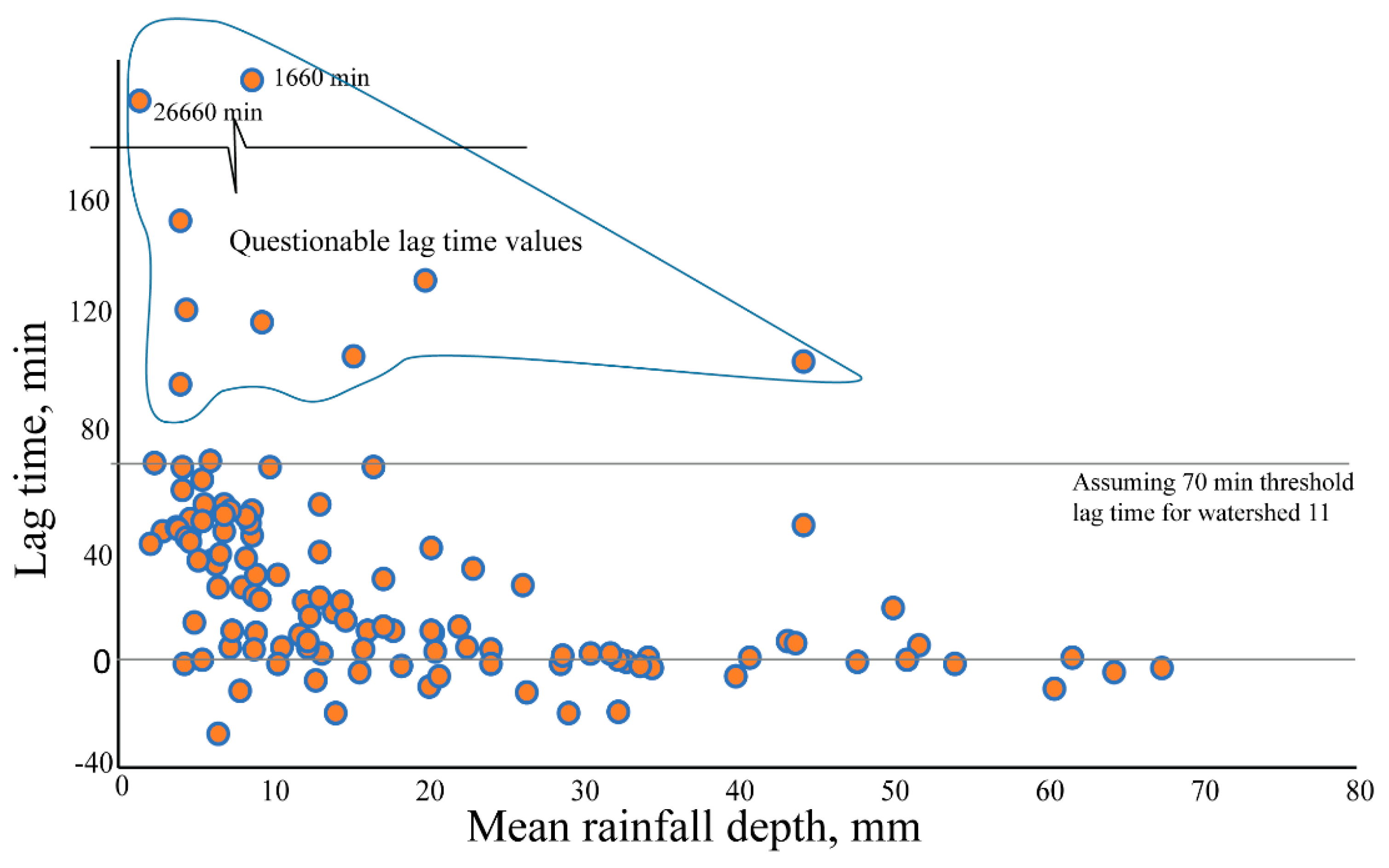


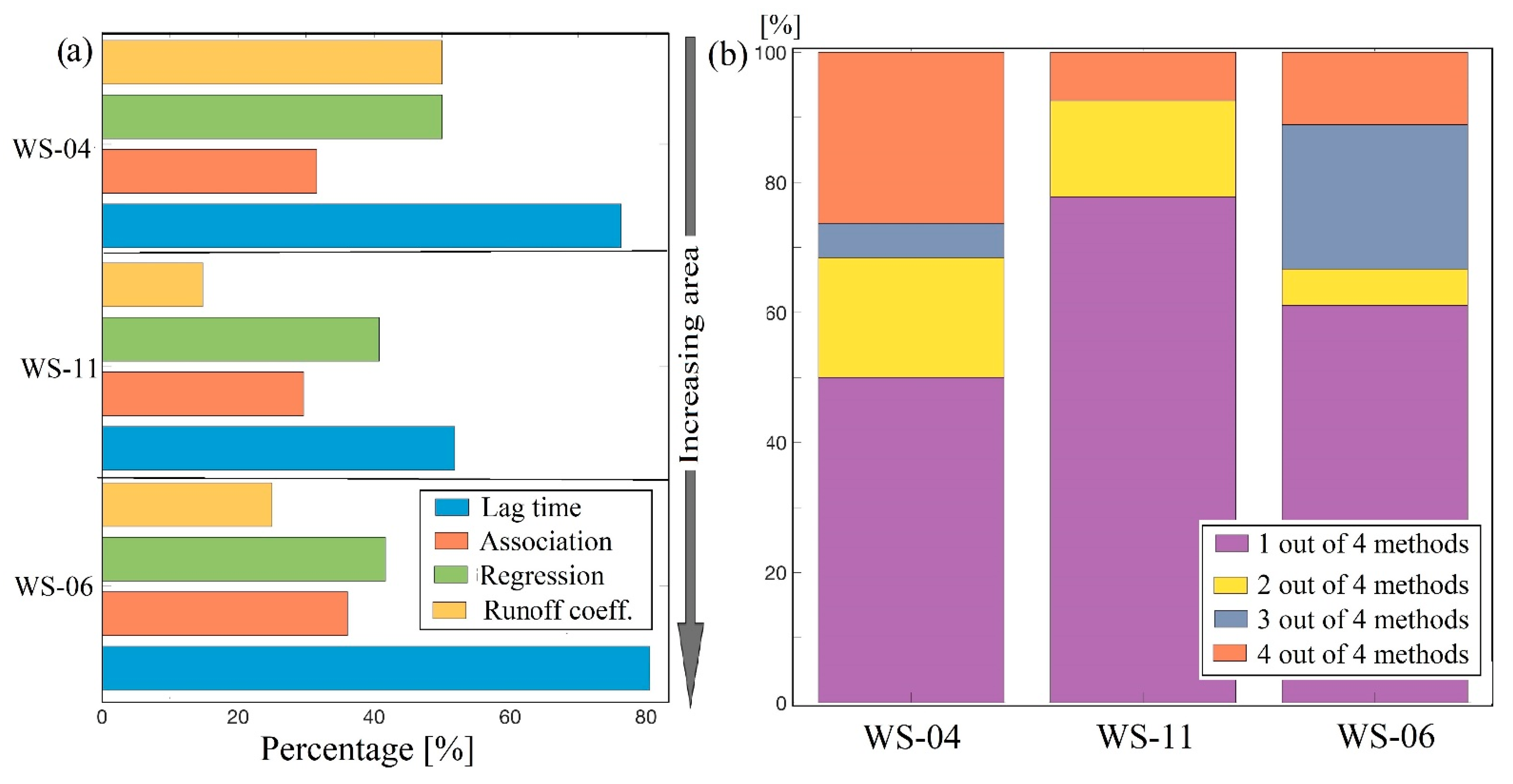
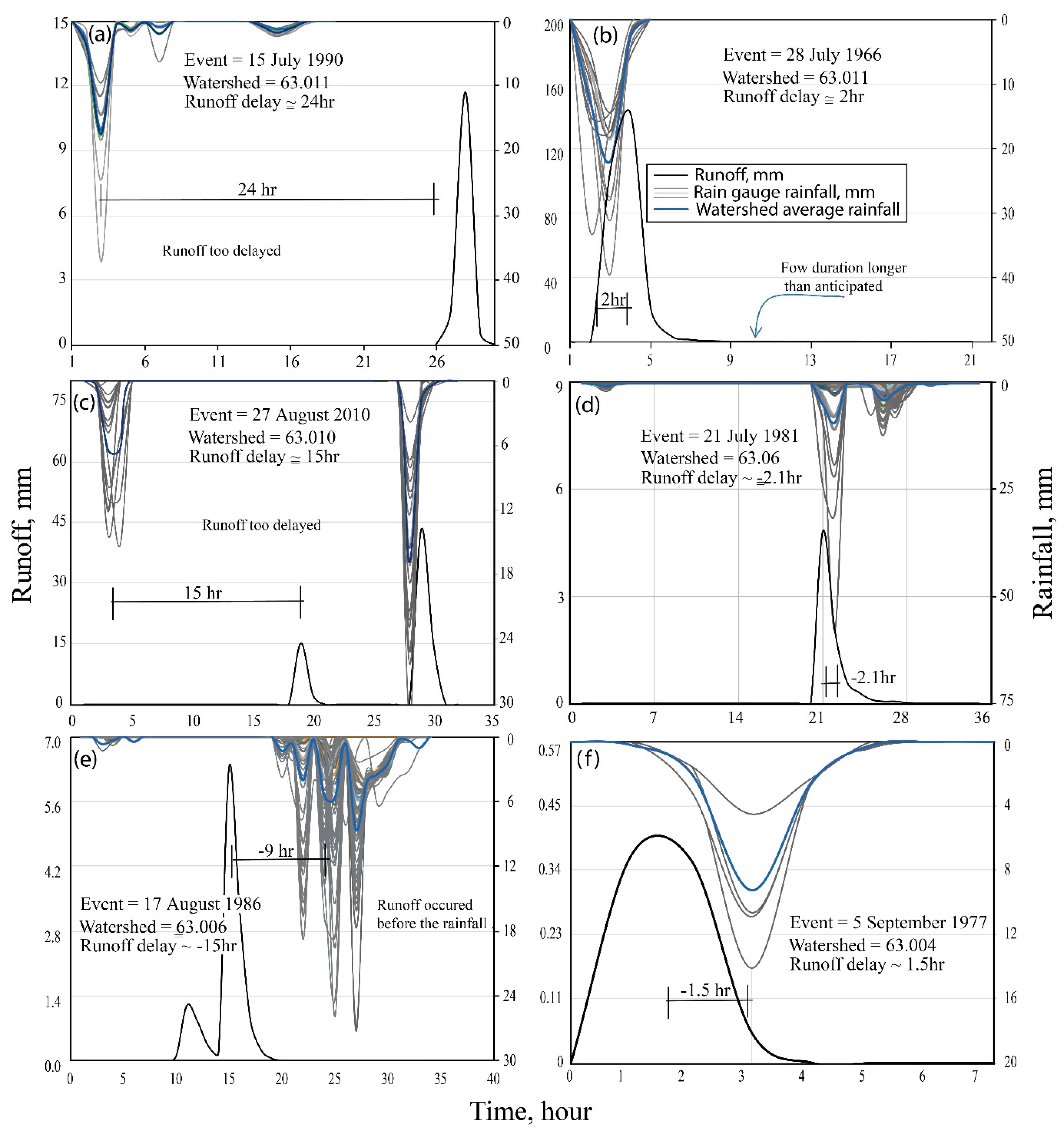
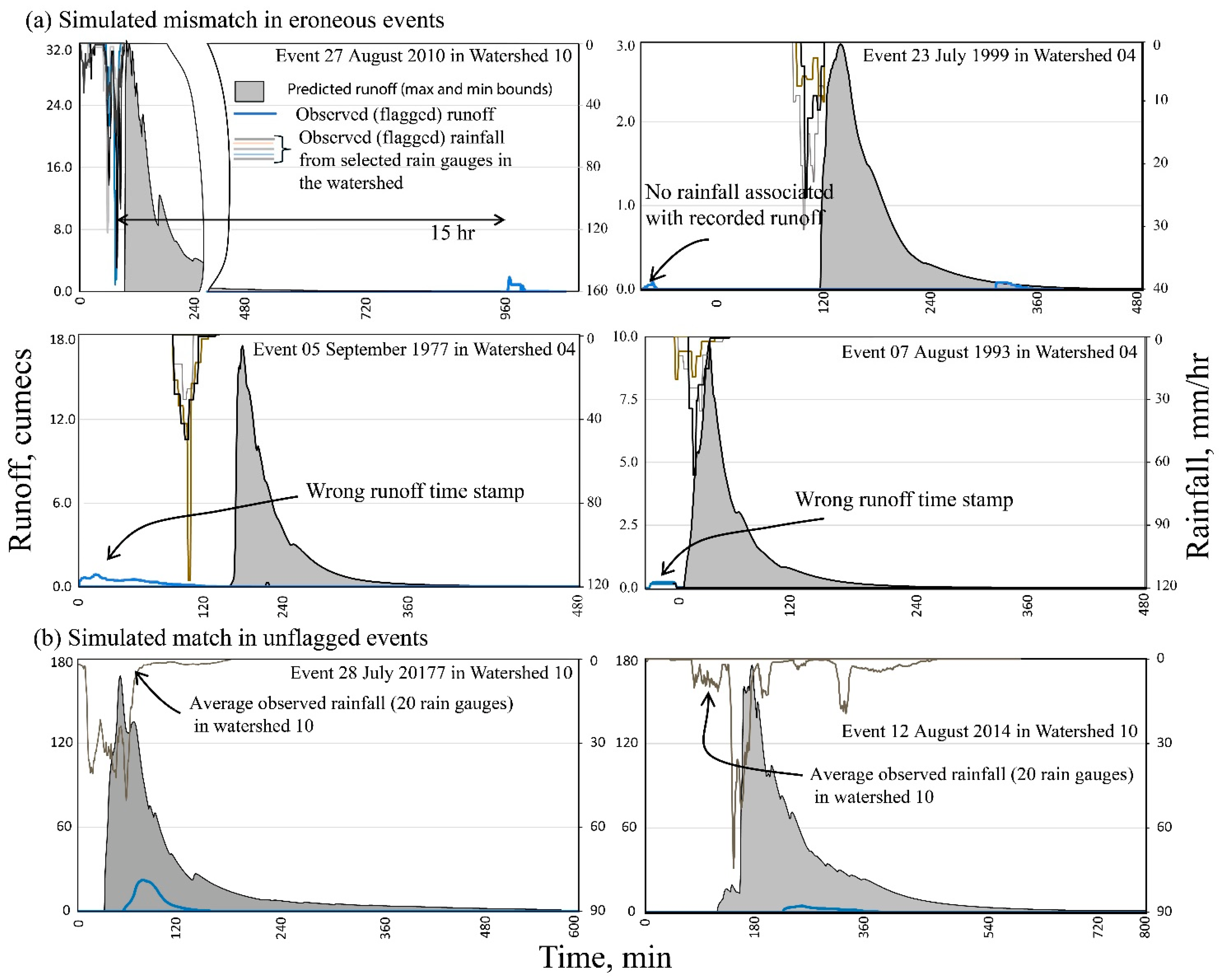
| Method | Pros | Cons |
|---|---|---|
| Rainfall Interpolation method (Rainfall) | Effectively identified rain gauge errors through the visual inspection of rainfall fields at daily time scale. | Inaccurate times coded to rainfall within a given day are hard to detect. Implementation at sub-daily time step is time consuming. It does not include identification of runoff. |
| Lag time method (Runoff) | Identified erroneous runoff events with runoff start time as early as one minute before the rainfall start time. Excessively large lag times indicate clear errors in the timing of either the runoff or the rainfall. | Runoff events triggered by heavy rain on the flumes could be erroneously flagged. Long duration rainfall and storms moving across the contributing areas may result in erroneous lag time. A threshold lag time value depends on the size of the watershed. The center of mass of the excess rainfall was computed for one of the rain gauges in the watershed, which may not be representative of the watershed scale observed rainfall. |
| Association method (Runoff) | Effectively identified runoff events without associated rainfall. The 7-h window, i.e., 3 h preceding and 3 h succeeding the maximum observation, was found to be a reasonable window for the rainfall or runoff. Effectively identified erroneous events with excessively long low flows once the runoff had receded. | An hourly mean of multiple rain gauges in the watershed was used which may remove some important information from the rainfall observations. An arbitrary threshold rainfall depth of less than 1 mm was considered as no rain. In some cases, the threshold value was a false alarm. It is hard to detect errors with short time error code shifts (<1 h). |
| Runoff Coefficient (Runoff) | Easy to implement in multiple sub-watersheds. Effectively identified runoff events without associated rainfall. | Sensitive to the threshold time used for computing C. |
| Regression method (Runoff and rainfall) | Successfully applied to all events regardless of observed runoff data. | Predicted runoff largely underestimated observations. High likelihood of predicting runoff from a given rainfall event for which no observations were available. |
Publisher’s Note: MDPI stays neutral with regard to jurisdictional claims in published maps and institutional affiliations. |
© 2022 by the authors. Licensee MDPI, Basel, Switzerland. This article is an open access article distributed under the terms and conditions of the Creative Commons Attribution (CC BY) license (https://creativecommons.org/licenses/by/4.0/).
Share and Cite
Meles, M.B.; Demaria, E.M.C.; Heilman, P.; Goodrich, D.C.; Kautz, M.A.; Armendariz, G.; Unkrich, C.; Wei, H.; Perumal, A.T. Curating 62 Years of Walnut Gulch Experimental Watershed Data: Improving the Quality of Long-Term Rainfall and Runoff Datasets. Water 2022, 14, 2198. https://doi.org/10.3390/w14142198
Meles MB, Demaria EMC, Heilman P, Goodrich DC, Kautz MA, Armendariz G, Unkrich C, Wei H, Perumal AT. Curating 62 Years of Walnut Gulch Experimental Watershed Data: Improving the Quality of Long-Term Rainfall and Runoff Datasets. Water. 2022; 14(14):2198. https://doi.org/10.3390/w14142198
Chicago/Turabian StyleMeles, Menberu B., Eleonora M. C. Demaria, Philip Heilman, David C. Goodrich, Mark A. Kautz, Gerardo Armendariz, Carl Unkrich, Haiyan Wei, and Anandraj Thiyagaraja Perumal. 2022. "Curating 62 Years of Walnut Gulch Experimental Watershed Data: Improving the Quality of Long-Term Rainfall and Runoff Datasets" Water 14, no. 14: 2198. https://doi.org/10.3390/w14142198






